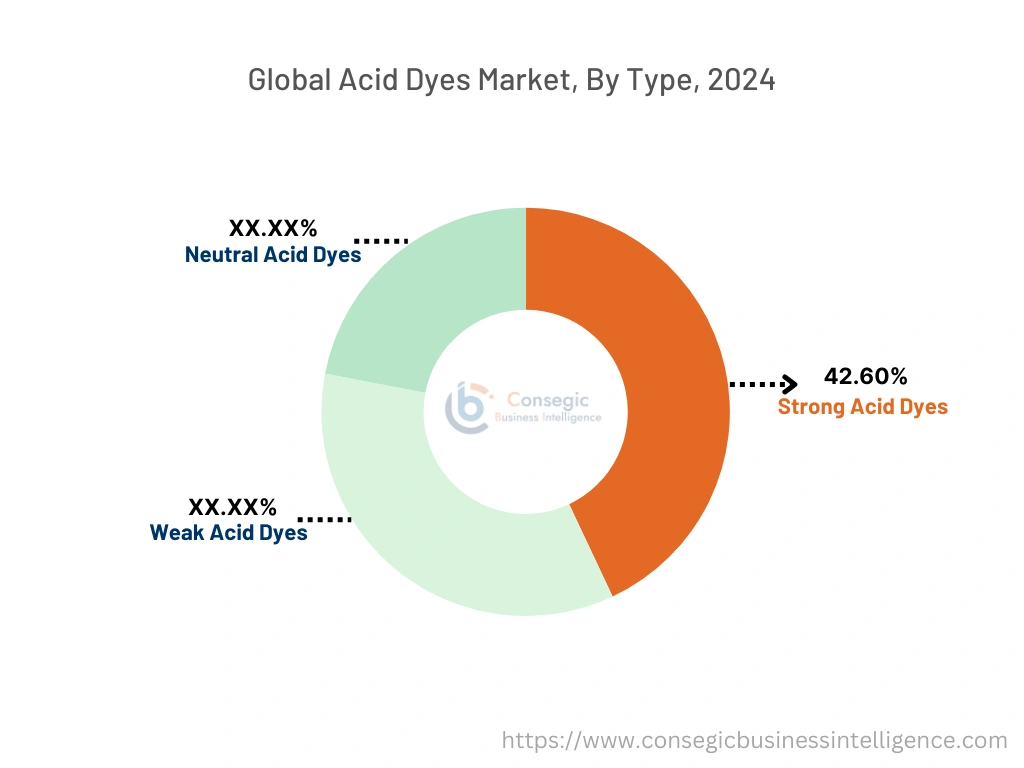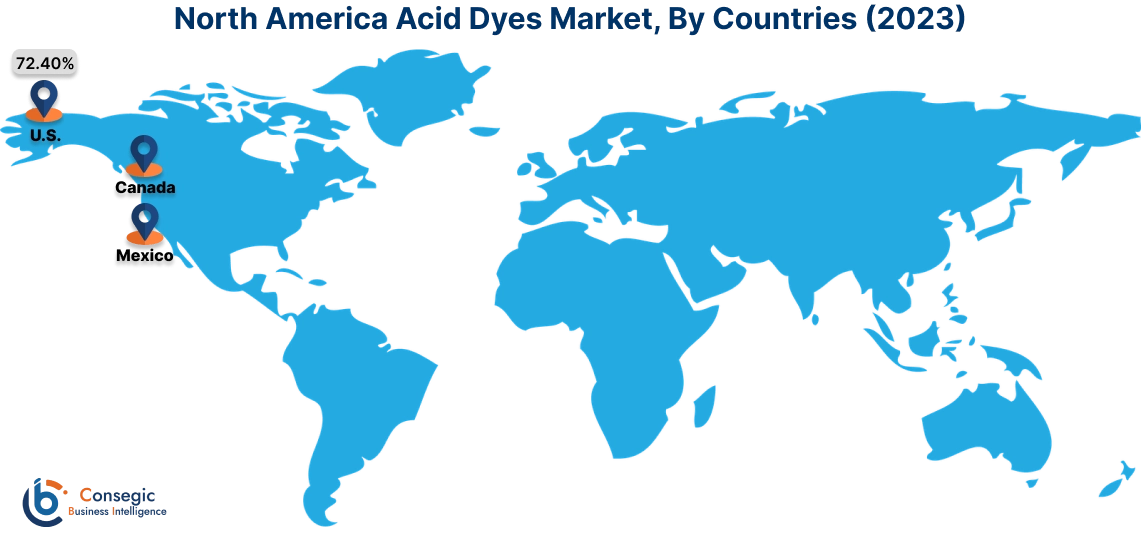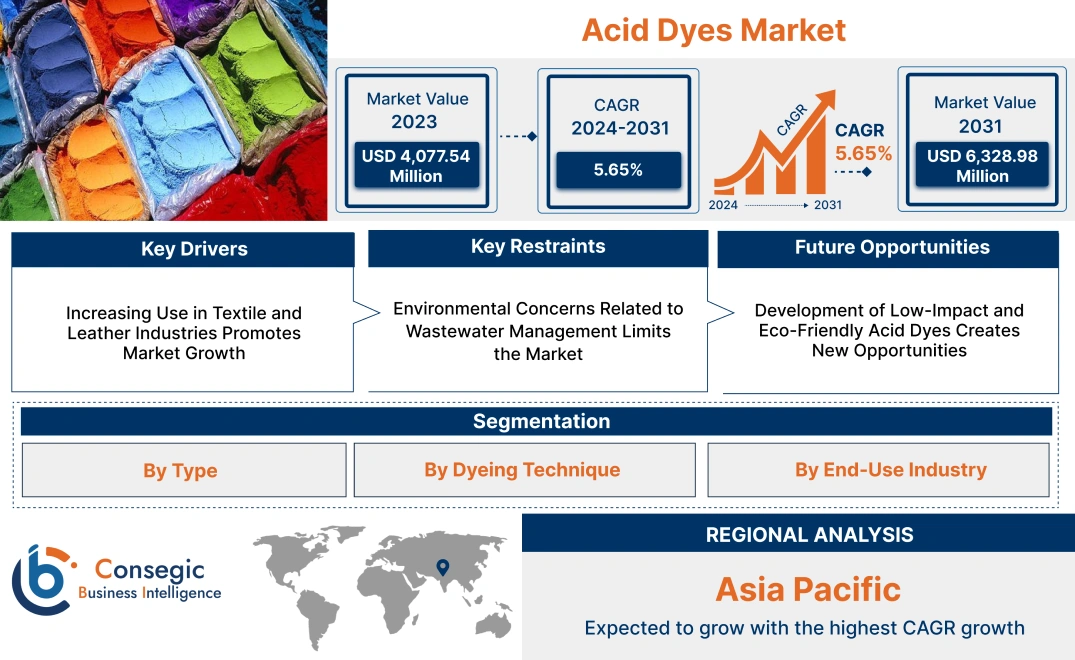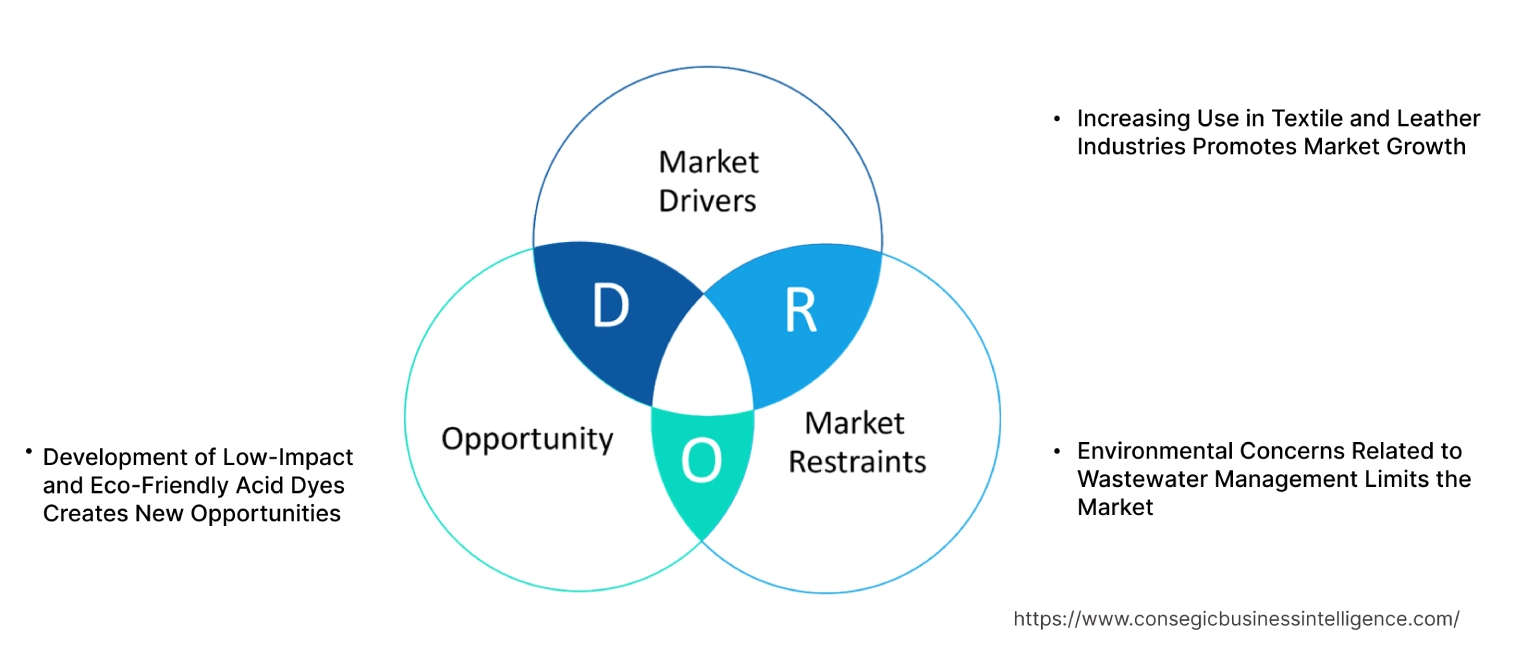Acid Dyes Market Size:
Acid Dyes Market size is estimated to reach over USD 6,328.98 Million by 2032 from a value of USD 4,077.54 Million in 2024 and is projected to grow by USD 4,235.26 Million in 2025, growing at a CAGR of 5.65% from 2025 to 2032.
Acid Dyes Market Scope & Overview:
Acid dyes are a type of water-soluble, anionic dye that is commonly used in textile dyeing, particularly for protein fibers like wool, silk, and nylon. They are characterized by their brilliant colors, good light fastness, and ability to be applied from an acidic bath. These dyes are anionic as they carry a negative charge in solution, allowing them to bond with the positively charged amino groups in protein fibers. They are highly water-soluble, making them suitable for various dyeing processes like immersion, exhaustion, and continuous dyeing. These dyes generally exhibit good light fastness, and they are resistant to fading or discoloration when exposed to light. They are used to dye a wide range of fabrics, including wool, silk, nylon, and modified acrylics. They are known for producing bright, vibrant colors that can be used to create various shades and tints.
Acid Dyes Market Dynamics - (DRO) :
Key Drivers:
Rising adoption of acid dyes in the paper industry is boosting the market growth
Acid dyes are used in the paper industry to color paper, particularly for creating deep, intense shades and achieving excellent colorfastness. They are applied to paper pulp in an acidic environment, binding to the paper fibers and distributing color evenly. The dye molecules bind to the paper fibers through hydrogen bonding, Van der Waals forces, and ionic bonding. The paper pulp is adjusted to a suitable pH level to create an acidic medium. Then, the acid dye is added, where it will bind to the fibers, resulting in a colored paper product. These dyes are frequently used for colored stationery, glossy paper for high-end publications, and other applications where deep, vibrant colors and durability are needed.
- For instance, Vidhi Industries offers a wide range of acid dyes in its portfolio. These dyes are suitable for utilization in the paper industry.
Thus, the aforementioned factors are driving the acid dyes market demand.
Key Restraints :
Environmental impact associated with acid dyes hinders the market growth
Acid dyes, a type of synthetic textile dye, can have significant negative environmental impacts, including water pollution, reduced sunlight penetration, and increased oxygen demand. They can also be toxic, mutagenic, and carcinogenic. They are often not biodegradable and can bioaccumulate in the food chain, posing a threat to aquatic life and potentially human health. Moreover, they discolor water bodies, making them visually unappealing and potentially affecting aesthetic quality. Additionally, they accumulate in organisms, potentially entering the food chain and affecting human health through contaminated food sources. Thus, the aforementioned factors are hindering the acid dyes market demand.
Future Opportunities :
Advancements in eco-friendly acid dyes create new market opportunities
Eco-friendly acid dyes are typically synthetic acid dyes, often formulated with sustainable manufacturing practices to minimize environmental impact and reduce the use of harsh chemicals. These dyes are designed to be less toxic and more biodegradable than traditional acid dyes, promoting safer handling and disposal. Eco-friendly acid dyes are often produced using sustainable manufacturing practices that minimize waste and reduce pollution. Azo dyes, a type of acid dye, have been identified as potentially harmful to the environment due to their high water pollution potential and the use of toxic chemicals in their manufacturing. These dyes often avoid or minimize the use of azo compounds.
- For instance, Dyes Sales Corporation provides eco-friendly dyes in its product portfolio. These dyes have a high water dissolving tendency, protein fibers effectiveness, level dyeing properties, and precise pH Value.
Thus, the rising advancements related to eco-friendly acid dyes are creating new acid dyes market opportunities.
Acid Dyes Market Segmental Analysis :
By Type:
Based on type, the market is segmented into strong acid dyes, weak acid dyes, and neutral acid dyes.
Trends in the Type:
- Rising adoption of strong acid dyes due to benefits including uniformity, resistance to fading, and others is boosting the acid dyes market size.
- Increasing trend in the adoption of weak acid dyes in milling due to their increased solubility in water.
The strong acid dyes segment accounted for the largest revenue of 42.60% in the acid dyes market share in 2024.
- Strong acid dyes, also known as leveling acid dyes, are a specific type of acid dye characterized by their excellent ability to level out uneven dyeing, ensuring a uniform color distribution.
- They are applied in a strong acidic medium, typically with a pH below 4, and are often used for dyeing protein fibers like wool, silk, and nylon. These dyes offer good colorfastness but may have limited wet fastness.
- Moreover, they require an acidic environment for optimal dyeing and bonding with the fibers.
- They are known for their ability to level out uneven dyeing, resulting in a uniform color on the fabric.
- In addition, these dyes generally exhibit good resistance to fading from light and washing.
- Thus, the aforementioned factors are driving the acid dyes market growth.
The neutral acid dyes segment is anticipated to register the fastest CAGR during the forecast period.
- Neutral acid dyes, also known as fast or supra-milling acid dyes, are a type of acid dye that can be applied to fabrics in a neutral or weakly acidic environment.
- They are particularly effective on protein fibers like wool, silk, and modified acrylics, and some can also be used on nylon.
- These dyes are known for their good wet fastness, and they resist color fading in water, but some may have less-than-ideal light fastness in pale shades.
- These dyes can be applied at a neutral pH or in a weakly acidic bath. They have a strong affinity for protein fibers, making them suitable for dyeing wool, silk, and other similar materials.
- They generally exhibit good wet fastness and can resist color fading when exposed to water or washing.
- Thus, the market analysis shows that the aforementioned factors are expected to boost the acid dyes market expansion.

By Dyeing Technique:
Based on dyeing technique, the market is segmented into exhaust dyeing, pad dyeing, loose stock dyeing, yarn dyeing, and printing.
Trends in the Dyeing Technique:
- Rising adoption of acid dyes for yarn dyeing, such as dyeing wool, silk, and nylon yarn, to facilitate vibrant and durable colors.
- Increasing trend in the adoption of loose stock dyeing to dye fibers (like wool) before being spun into yarn.
The exhaust dyeing segment accounted for the largest revenue share in the acid dyes market share in 2024.
- Exhaust dyeing with acid dyes involves using an aqueous dye bath where the dye is transferred from the bath to the fiber (exhaustion).
- This method is often used for fibers like wool, nylon, and silk. The process typically includes heating the dye bath, adding the fiber, and then controlling the temperature and pH to optimize dye uptake.
- It can be a relatively fast dyeing process, particularly in machines like winches, jiggers, or jet dyeing machines.
- Thus, the market analysis shows that the aforementioned factors are driving the acid dyes market trends.
The printing segment is anticipated to register the fastest CAGR during the forecast period.
- Acid dye printing involves creating patterns on protein fibers like silk, wool, and nylon using special inks that bond with these fibers.
- These inks are formulated to be vibrant, colorfast, and tolerant of chlorine and saltwater.
- The process often involves using a print paste with a weak acid and a thickening agent, followed by steaming and washing to fix the colors.
- Thus, the rising adoption of acid dye printing is boosting the acid dyes market trends.
By End-Use Industry:
Based on end-use industry, the market is segmented into textiles, leather, paper, food & beverages, and others.
Trends in the End-Use Industry:
- Rising demand for acid dyes in textiles due to their uniformity and vibrant color results.
- Increasing trend for acid dyes in the food & beverages industry to add visual appeal and color is boosting the acid dyes market size.
The textiles segment accounted for the largest revenue share in 2024.
- Acid dyes are used in the textile industry, primarily to color protein fibers like wool and silk, as well as synthetic fibers like nylon.
- They work by forming bonds with the fiber molecules under acidic conditions, producing vibrant and colorfast results.
- Wool and silk are commonly dyed with acid dyes due to their affinity for these fibers and the ability to produce vibrant colors.
- Nylon is also a common target for acid dyes, offering excellent colorfastness and uniformity.
- Acid dyes can be used to color fabrics containing both protein and synthetic fibers, achieving consistent and even coloration.
- Thus, the market analysis depicts that the aforementioned factors are driving the acid dyes market growth.
The food & beverages segment is anticipated to register the fastest CAGR during the forecast period.
- Acid dyes, specifically those approved for consumption, are used in the food and beverage industry to add color and visual appeal to various products like beverages, candies, and processed foods.
- These dyes, also known as food dyes or color additives, are used in a variety of food products to enhance or impart color, create a specific appearance, or replace colors lost during processing.
- Acid dyes are added to soft drinks, juices, and flavored water to create vibrant and eye-catching colors.
- They are used in candies, baked goods, and desserts to impart appealing colors and create visually striking products.
- Moreover, acid dyes are also used in processed foods like cereals, snacks, and sauces to achieve consistent and appealing colors.
- Thus, the acid dyes market analysis shows that the aforementioned factors are expected to boost the acid dyes market expansion.
Regional Analysis:
The regions covered are North America, Europe, Asia Pacific, the Middle East and Africa, and Latin America.

In 2024, North America was valued at USD 1,352.55 Million and is expected to reach USD 2,051.22 Million in 2032. In North America, the U.S. accounted for the highest share of 72.40% during the base year of 2024. North America holds a significant share in the acid dyes market. The market growth in the region is driven by the usage of acid dyes in applications such as food packaging and inks. Thus, the market analysis shows that the aforementioned factors are driving the acid dyes market opportunities.

According to the acid dyes market analysis, the market in Asia-Pacific is experiencing the fastest growth with a CAGR of 6.1% over the forecast period. Asia-Pacific is the largest and fastest-growing region in the acid dyes market, driven region's significant role in textile manufacturing and global trade. These dyes are used in a variety of applications in Asia, including dyeing wool, silk, nylon, leather, and paper. They are also used in the production of food colorings and inks.
Europe is a prominent market for acid dyes, due to the wide usage of acid dyes in the textile, leather, and food industries. The Middle East & Africa region is witnessing steady growth in the acid dyes market, driven by rising demand in the textile and leather industries. Latin America analysis depicts it as an emerging market for acid dyes, with a growing textile and apparel industry that relies on various dyes, including disperse dyes and acid dyes.
Top Key Players and Market Share Insights:
The acid dyes market is highly competitive with major players providing products and services to the national and international markets. Key players are adopting several strategies in research and development (R&D), product innovation, and end-user launches to hold a strong position in the global acid dyes market. Key players in the acid dyes industry include -
- Atul Ltd. (India)
- BASF SE (Germany)
- Setas Color Center (Turkey)
- Rudolf GmbH (Germany)
- Zhejiang Runtu Co., Ltd. (China)
- Gayatri Group (India)
- Clariant International Ltd. (Switzerland)
- Huntsman International LLC (USA)
- Kiri Industries Ltd. (India)
- Camex Limited (India)
Recent Industry Developments :
Innovations:
- In December 2024, Kyung-In Synthetic Corporation (KISCO), a South Korean conglomerate, is advancing sustainability in textile dye production through several initiatives such as Sustainable Manufacturing: KISCO implements eco-friendly processes, surpassing regulatory standards for air emissions and wastewater discharges, ensuring environmental protection.
Acid Dyes Market Report Insights :
| Report Attributes | Report Details |
| Study Timeline | 2019-2032 |
| Market Size in 2032 | USD 6,328.98 Million |
| CAGR (2025-2032) | 5.65% |
| By Type |
|
| By Dyeing Technique |
|
| By End-Use Industry |
|
| By Region |
|
| Key Players |
|
| North America | U.S. Canada Mexico |
| Europe | U.K. Germany France Spain Italy Russia Benelux Rest of Europe |
| APAC | China South Korea Japan India Australia ASEAN Rest of Asia-Pacific |
| Middle East and Africa | GCC Turkey South Africa Rest of MEA |
| LATAM | Brazil Argentina Chile Rest of LATAM |
| Report Coverage |
|
Key Questions Answered in the Report
What is the projected market size of the Acid Dyes Market by 2031? +
Acid Dyes Market size is estimated to reach over USD 6,328.98 Million by 2032 from a value of USD 4,077.54 Million in 2024 and is projected to grow by USD 4,235.26 Million in 2025, growing at a CAGR of 5.65% from 2025 to 2032.
What drives the demand for acid dyes in the textile and leather industries? +
Acid dyes are highly favored for their ability to produce vibrant and durable colors, particularly for protein fibers like wool, silk, and nylon. Their application in high-quality textiles, leather goods, and home décor drives demand, supported by trends in customization and eco-conscious manufacturing.
Which type segment dominates the Acid Dyes Market? +
The strong acid dyes segment holds the largest revenue share due to its extensive use in textile applications, offering vibrant colors, high colorfastness, and compatibility with various dyeing techniques.
What are the primary challenges faced by the Acid Dyes Market? +
Environmental concerns related to wastewater management, containing toxic components from dyeing processes, pose significant challenges. High costs for advanced treatment technologies and stringent regulations also impact the market.
Which dyeing technique is most widely used? +
The exhaust dyeing technique dominates the market due to its ability to deliver uniform and deep dye penetration, making it a preferred choice for mass production of textiles like wool and silk.


